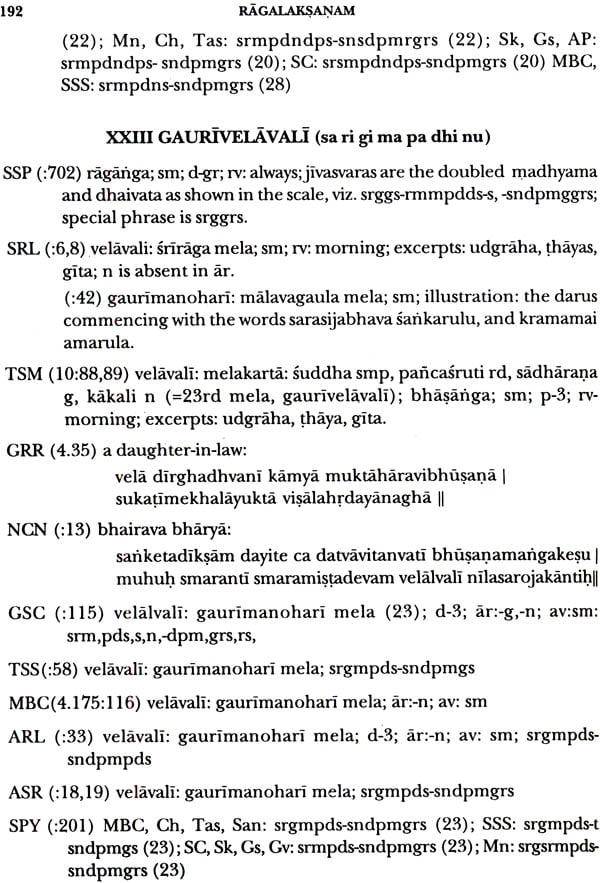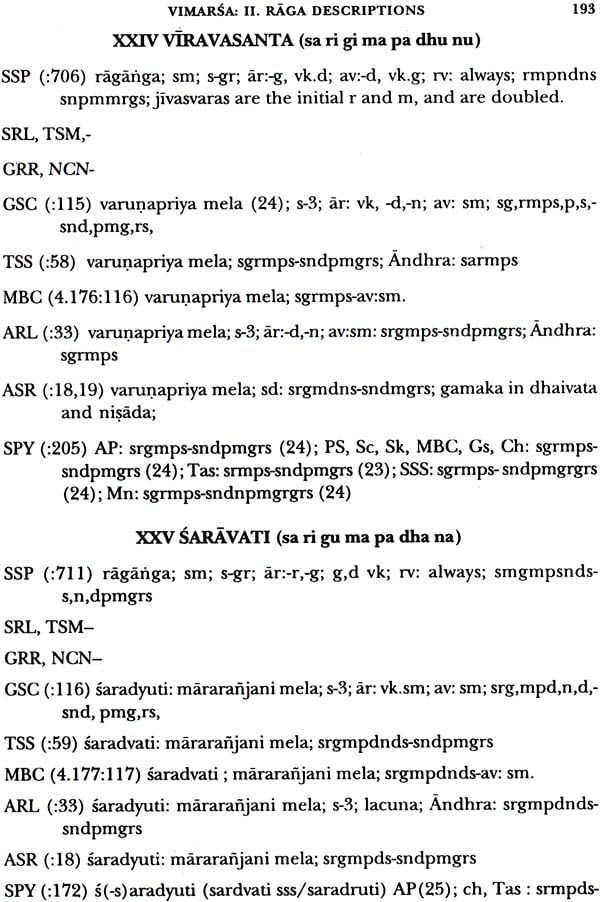
Ragalaksanam (With Roman)
Book Specification
| Item Code: | NAB735 |
| Author: | R. Sathyanarayana |
| Publisher: | Indira Gandhi National Centre for the Arts and Motilal Banarsidass Publishers Pvt. Ltd. |
| Edition: | 2010 |
| ISBN: | 9788120834088 |
| Pages: | 385 |
| Cover: | Hardcover |
| Other Details | 10.0 inch X 7.5 inch |
| Weight | 1.06 kg |
Book Description
Ragalaksanam was composed by Mudduvenkatamakhin in Tanjore in the early 18th century AD. It is an important text of Karnataka Music and appeared in an effervescent epoch in the development of this music system of which it i deals with only raga. It collects, classifies, codifies and characterizes the entire music base of the Indian peninsula. The author was musician, musicologist and music composer of high order. His contribution to the world of music is twofold;
systematisation of the theory of raga content of his times and creating music to crystallise the character and scope of each raga described.
The author derived his inspiration from his great- grandfather, Venkatamakhin who revolutionised the theory and practice of Indian music through his scheme of 72 melas. His Caturdandiprakasika illustrates the four fundamental components (dandi) of music — gita, alapa, thaya and prabandha, which his paramaguru (teacher’s teacher) Tanappa postulated and illustrated. His own guru was his father Govindadiksita who made the first efforts to stabilize the four dandis in practice in his Sangitasudha.
Thus a line of four important musicians•— musicologists-composers of South India: Tanappa, Govindadiksita, Venkatamakhin and Mudduvenkatamakhin built up or reorganized a textual tradition which supported a living dynamic tradition of performed music in which hundreds of composers, thousands of performers and countless listeners endeavoured to continuously strengthen and nourish it. Ragalaksanam marks an important phase of this great evolution.
Prof. R. Sathyanarayana an internationally acclaimed authority on Indian music and dancing. He is broadbased in several physical sciences, humanistic and indological disciplines. He is widely acclaimed for his systematic contributions in the intra- disciplinal and inter-disciplinal bases of modern Indian musicology and danceology.
He has published numerous books, including critical editions, translations, commentaries, annotations, monographs, original creative works, and research papers on Indian music, dancing and other cognate subjects. He has received numerous academic distinctions (including doctoral degrees, fellowships, and honorific titles) awards and honours. He is a guide and examiner for doctoral examinations.
Prof. Sathyanarayana’s critical edition, translation, critical introduction and commentary etc. of Pandarika Vitthala’s Nartananirnaya, Caturdandiprakasika and Makhihrdaya have been published in the Kalamulasastra Series.
The Kalamulasastra series is aimed at bringing to light the primary textual source material hitherto unknown, unpublished or inaccessible both in original language as also in translation. This is symbolically conceived as a series of 108 texts at the first instance. Under this ongoing and long range research programme, the publication of the fundamental texts of Indian Arts is undertaken along with annotation and translations.
The critical edition of each text under this programme is prepared on the basis of several manuscripts, those being collated, transcribed, etc. along with the commentary of the source material, if any. So far, nine such texts on musicology have been brought out in this series and the present volume is another value addition. It is a matter of immense pleasure for us at IGNCA to publish this work on musicology under the Kalamulasastra series. The 18th century fundamental text, viz. Ragalaksanam, composed by Sri Mudduvenkatamakhin in Tanjore, is important to the development of Karnataka music.
Mahamahopadhyaya Dr. R. Sathyanarayana, a polymath of our times and an authority in the Held of Indian musicology and danceology, has critically edited and translated this text with copious commentaries and a detailed introduction. The edition paves the way for a better comprehension of this genre of classical music. The longstanding controversy of authorship of text has been resolved by Dr. R. Sathyanarayana on the basis of careful examination of all available data. It is hoped that the academic fraternity will be benefited by this endeavour. The IGNCA stands beholden to Prof. Sathyanarayana for his scholarly contribution to the field of Indian musicology in particular and to Indian Arts in general.
Ragalaksanam is a sequel to Caturdandiprakasika of Venkatamakhin and Makhihrdaya. The former is a definitive text of Karnataka music and the latter, a penetrative, perceptive and massive commentary on the same, both written by Prof. R. Sathyanarayana and published in the Kalamulasastra series. This triad is nodal to developing the history of evolution of the melodic content of Karnataka Music.
If Caturdandiprakasika may be regarded as forming the rearguard in the pageant of modern usage of ragas in Karnataka music, Ragalaksanam forms the vanguard of this procession. Together with the respective contemporary sources analysed and evaluated in these two texts as well as the intervening Makhihrdaya, we have a more or less continuous history, tradition and usage of ragas in Karnataka music till the middle of 20th century. The contribution of this period 1950 — 2009 only augments and supports its inheritance. A special feature of the present volume is the inclusion of available compositional material in all its variety and bulk from 1650 A.D. to 1950 A.D., even if only in enunciation. If the musical score of this material is fully discovered and is analysed in a historical method, a clearer picture of March of our music — in both theory and practice - of Karnataka music (ragas) would emerge. The book also carries critical Notes and a comprehensive Commentary on each Chapter named Vimarsa which is aimed to endow the original text both continuity and contemporaneity on a broad base.
Indira Gandhi National Centre for the Arts deserves to be congratulated and commended for this achievement. A similar treatment of tala and musical form as well as a contemporary history of Karnataka music are much needed and would be welcomed.
I thank the Indira Gandhi National Centre for the Arts, New Delhi for including this volume in the Kalamulasastra series. I am beholden to its enlightened officers namely, Prof. G. C. Tripathi, V. S. Shukla, Dr, Sushma Z. Jatoo and Dr. Sudhir Lall for the unfailing help and courtesy extended to me during the production of this work. Sri N. S. Sharada Prasad marked the Index exhaustively. No words are adequate to express my gratitude for the long hours beyond midnight in which my son Sangita Vidwan R. S. Nandakumar and my disciple R. Pavan have toiled and struggled with the enormous index material and proof reading. Keerthan Graphics, Mysore has neatly executed the DTP work.
Author is not Venkatamakhin
Ragalaksanam appeared in print for the first time in 1934 A.D. as an appendix to Caturdandiprakasika of Venkatamakhin, published by the Music Academy, Madras as Music Academy Series No.3. It was jointly edited by Pandit S. Subrahmanyasastri, T. V. Subba Rao and (justice) T. L. Venkataramayyar. The edition was based on a single exemplar of the work in the possession of Muddusvami Diksita of Ettayapuram, son of Subbarama Diksita. This Manuscript was a family heirloom, acquired by Ramasvami Diksita, great grandfather of Muddusvami Diksita, (possessor of the MS), grandfather of Subbararna Diksita and father of the great music composer Muddusvami Diksita (and of his brothers CinnasvamiDiksita and Balusvami Diksita). Ramasvami Diksita himself received the work from a direct descendent of Venkatamakhin. Thus the Diksita family was the sole custodian of the MS which is a valuable document of the Makhiparampara in music.
The editors of Caturdandiprakasika have named this. part of the book as ‘Anubandha’ (appendix, addendum). They believe. that this part of the. work was authored by Venkatamakhin himself:
‘Venkatamakhin wrote two works on Music. One is the Chaturdandi Prakashika and the other deals with Ragalakshana. In Chaturdandi Prakashika, we find the fundamental principles enunciated but their practical application was explained in another treatise dealing specially with Ragas and their Lakshanas. In this latter work Venkatamakhin gave his nomenclature of the 72 melas and classified the Janya Ragas under the several Melas. He illustrated them by a number of Lakshana Gitas, some of which are printed in the Sangita Sampradaya Pradarshini'. (Caturdandi Prakashika, preface, p.vi).
The learned editors seem to have depended for this solely on Subbarama Diksita's assertions in the Sangita Sampradaya Pradarsini that both the Ragalaksana slokas and the gitas therein are of Venkatamakhin, In this connection, the following points deserve to be noted:
1) Venkatamakhin proposes the 72-mela scheme purely as a mathematica model. He is quite aware that the 72 melas have no actual existence His model is intended to comprehend all melodic possibilities within the framework of twelve svarasthanas and sixteen svara denominations With such background he describes the actual melas and their derivative: prevailing at his time.
2) Similarly named ragas are described very differently in Caturdandiprakasika and the ‘Anubandha’.
3) Ghana-naya-desya raga classification of ragas of ‘Anubandha’ did not exist at the time of Venkatarnakhin.
4) The literary styles of the two works are entirely dissimilar.
5) Mela is defined a suddhasampurna (i.e. possessed of all seven notes in regular order in both ascent and descent) in the raga scale by Venkatamakhin. Many raganga ragas (synonymous with mela) in the ‘Anubandha’ are described as asampurna (i.e. possessed of less thar seven notes and / or arranged in irregular order in ascent and/ or decent in the raga scale) .
6)The interval suddha madhyamagandhara (in the raga saranga) is totally unknown to Verikatamakhin.
7)Venkatamakhin does not show his awareness of ka-ta-pa-yadi scheme of nomenclature in any of his works.
8)Names of the nineteen melas of Caturdandiprakasika and of their derivative ragas are often quite different in the ‘Anubandha’.
9)Raga descriptions in the ‘Anubandha’ are very sketchy and ofter inadequate for practical usage.
10)The stigma ‘turuskanam atipriyah’ (raga kalyani, CDP 5.107) ‘pamarapriya’ (raga pantuvarali, ibid., 5.108) was no longer attached to these ragas in the ‘Anubandha’, but other desya ragas, viz. bilaval yamunakalyani, bibas, darabaru, nayaki, brndavani jujavati, ramakali pharaju, hambiru, kakubha, etc. which were imported into the royal courts of Bhosle rulers of Tanjore had crept in.
Cause of Confusion
These and similar considerations rule out the possibility of a single authorship of both works. It is quite possible that Subbarama Diksita continued to harbour the traditional family belief, probably inaugurated by Ramasvami Diksita himself. It is also possible that the prefix 'Muddu' eroded in course of time in an aural tradition, leaving behind only Venkatamakhin. The inherited Ragalaksana slokas had grown quite corrupt by oral transmission or repeated copying of the 'Anubandha'. It should be noted that Subbarama Diksita quotes very sparingly from Caturdandiprakasika. This is probably because the 'Anubandha' was more of immediate, practical application and the Caturdandiprakasika must have appeared irrelevent or obsolete. The term 'Anubandha' was implicitly accepted by the reader. It created an impression that it was added by the author of Caturdandiprakasika himself as an afterthought. Then it came to be specified as Ragalaksana Appendix.
| Publisher’s Note | vi | |
| Preface | vii | |
| Abbreviations | viii | |
| Detailed Contents | xi | |
| List of Tables | xvi | |
| Scheme of Transliteration | xvii | |
| Introduction | 1 | |
| Text and English Translation | 11 | |
| Critical Notes and Commentary | 49 | |
| Index: | ||
| Authors | 345 | |
| Works | 347 | |
| Composers | 350 | |
| Technical Terms | 352 | |
| Ragas | 358 | |
| Names | 365 | |
| Miscellaneous Terms | 367 | |
| Places | 370 |







